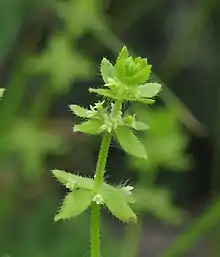Cruciata pedemontana
Cruciata pedemontana, the Piedmont bedstraw, is a species of plant in the Rubiaceae. It is native to the southern and central Europe, the Black Sea Basin, and southwestern and Central Asia from Turkey to Iran to Kazakhstan. It is also naturalized in parts of the United States (south-central and eastern parts from Texas to New York, plus the northwest from Washington and Oregon to Montana).[1][2][3]
| Piedmont bedstraw | |
|---|---|
 | |
| Stalk of Piedmont bedstraw | |
| Scientific classification | |
| Kingdom: | Plantae |
| Clade: | Tracheophytes |
| Clade: | Angiosperms |
| Clade: | Eudicots |
| Clade: | Asterids |
| Order: | Gentianales |
| Family: | Rubiaceae |
| Genus: | Cruciata |
| Species: | C. pedemontana |
| Binomial name | |
| Cruciata pedemontana (Bellardi) Ehrend. | |
| Synonyms[1] | |
| |
Cruciata pedemontana is an erect herb up to 30 cm (12 in), covered with stiff hairs. Leaves are broadly ovate, usually four per node. Flowers are tiny, rarely more than 1 mm (0.039 in) across, axillary, pale yellow.[4]
Varieties
Two varieties are recognized (as of May 2014):[1]
References
- Kew World Checklist of Selected Plant Families, Cruciata pedemontana
- Biota of North America Program, Cruciata pedemontana
- "Cruciata pedemontana [Crocettona piemontese] - Flora Italiana". luirig.altervista.org. Retrieved 2021-10-08.
- "Flora Vascular - Toda la informacin detallada sobre la Flora Vascular | - Especie: Cruciata pedemontana | BioScripts.net". www.floravascular.com. Archived from the original on 2012-05-27. Retrieved 2021-10-08.
External links
- US Department of Agriculture plants profile,
- US Department of Agriculture, National Forest Service, weed of the week Archived 2016-03-05 at the Wayback Machine,
- Vanderbilt University, Piedmont bedstraw
- Flore Alpes, Croisette du Piémont
- Flora Acta Plantarum,
- Botany Czech, svízelka piemontská / krížavka piemontská
- Flora-On, Portugal,
- Botanik im Bild / Flora von Österreich, Liechtenstein und Südtirol, Piemont-Kreuzlabkraut / Piemonteser Kreuzlabkraut
- Discover Life,
- Southeastern Flora,
- Eastern Washington University, Flora of Eastern Washington and Adjacent Idaho Archived 2016-03-06 at the Wayback Machine,
- Botanische Spaziergaenge, Bilder von Österreichs Flora, Cruciata pedemontana / Piemont- Kreuzlabkraut
- Eastern Forests Threat Center, Piedmont bedstraw
This article is issued from Wikipedia. The text is licensed under Creative Commons - Attribution - Sharealike. Additional terms may apply for the media files.